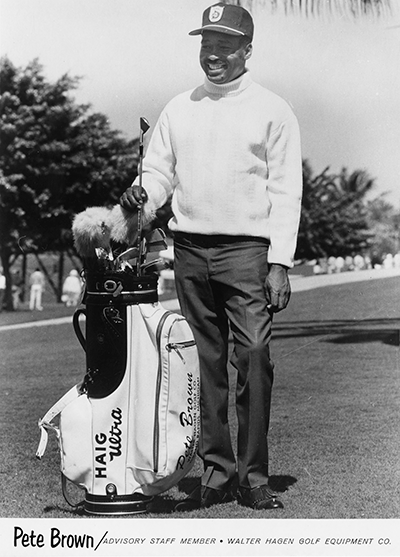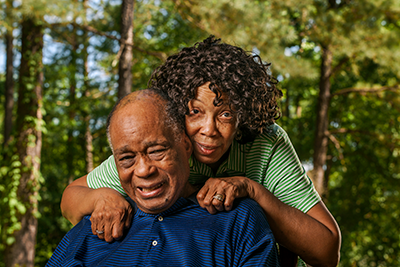[ad_1]

Word: This piece was written by Rhonda Glenn and initially ran on usga.org on October 28, 2012. Brown died on Could 1, 2015, on the age of 80.
Until you’re Pete Brown, it’s just a few hundred miles from Jackson, Miss., to Augusta, Ga. Brown, nevertheless, traveled a tough street, one which wound by means of Southern California and Ohio, a street suffering from hazards and triumph, unhealthy reminiscences and good buddies, till lastly, he’s again in his beloved South.
Pete Brown, 77, holds a novel place in golf historical past – one which solely he has stuffed but one commensurate with the accomplishments of the extra well-known Charlie Sifford and Lee Elder. A full technology in the past, Pete Brown was the primary black participant to win on the PGA Tour.
Amongst black golfers, poverty and post-segregation slights are acquainted tales. Brown, like others, overcame them. It was polio, the crippling scourge that plagued so many so way back, that almost all threatened Brown’s future and his life.
Like Sifford, Jim Dent and different male golfers of coloration, Brown got here out of the caddie ranks with a self-taught golf swing. At 11, he noticed that caddieing provided a much bigger payday. He made $6 a day for 36 holes at a public course. Like plenty of black youngsters, the caddies used discarded golf equipment to hit balls on vacant farmland. In Mississippi, Brown was the perfect of the lot. By the age of 17, at any time when he performed a full-length course he broke 70.
That’s when a lightweight went on. Perhaps he may make a residing taking part in golf.
He labored on his recreation, made just a few buddies, and traveled to tournaments. In Houston, he completed second to Invoice Spiller within the Lone Star Open, a match for black gamers. Sifford urged him to remain beginner. “He mentioned I wanted expertise, however I needed to win a little bit cash so I may maintain making an attempt to play,” Brown mentioned. “That’s the one motive I turned professional.”
Brown went to Detroit to get in on the betting motion. Randolph Wallace, a rich black businessman, provided to ship him to varsity. It was 1956 when he suffered a tragic setback. Polio struck Pete Brown and he would spend greater than a 12 months in a hospital mattress.
“You’d higher discover one other sport,” Brown’s physician informed him. “I don’t assume you’ll be capable to stroll once more.”
Largely ignored, Brown lay in mattress for 4 months. In the future, Sifford introduced heavyweight boxing champ Joe Louis, who liked golf, to go to. Brown was asleep, so the champ left an autographed image.
Louis wrote on the picture, “Hurry up and get out of that mattress so we are able to kick your butt. Joe Louis.”
Medical personnel paid nearer consideration after that. Brown was lastly identified and coverings started. Every week, he obtained three injections in his again, the ache so intense it took 5 folks to carry him down. Earlier than one injection, he tried to leap by means of the window. Dragging his withered physique throughout the room, he collapsed on the ground.
These reminiscences are so disagreeable that Brown winces as he talks.
In 1957, a kind of miracle occurred: Pete Brown moved his toes. His therapists started stretching Pete’s legs and he quickly was in a position to make just a few tentative steps. Inside weeks, he was on the hospital garden making painful swings with a golf membership. Late in 1957, he left the hospital. He had been in mattress for greater than a 12 months.
Pete went to a driving vary and commenced hitting observe balls. Between pictures, he rested in a chair.
“I couldn’t hit the ball,” he remembered. “I missed it loads. However I needed to be in Houston in June.”
To Brown, Houston was the massive apple. A match there was performed by the United Golfers Affiliation, the group that hosted occasions for black golfers at a time when most tournaments allowed solely whites to play.
Brown made it to Houston, however after all didn’t play nicely. That he performed in any respect was miraculous. Over the following months he slowly labored to get his recreation in form. It was an amazing day when he lastly received the Lone Star Open. He would go on to win it 4 occasions. He captured the UGA’s Nationwide Negro Open 4 occasions. In 1961, he received the Michigan Open and his grueling keep within the hospital appeared a very long time in the past.
Now, different threats intruded.
“I wasn’t in competition till the final spherical,” Brown mentioned. “It was actual windy and chilly. The final spherical I shot a 67 and form of lapped the sphere to make a playoff. All these folks had been on the primary tee and I used to be so completely satisfied to shoot the 67. We teed off and had been on the inexperienced when some youngsters down the road they yelled [a racial insult] and mentioned, ‘Hey! What you doing in there?’ “
So what did Pete Brown do, with all these folks there? He laughed.
“As a result of it was no huge deal,” he mentioned. “All people began laughing then. You nearly should be good and so they’ll go away you alone. In the event you problem them, then you definately’re in bother. I realized that again in Mississippi.”
On the second playoff gap, a par 5, Brown hit the inexperienced in two pictures and two-putted for a successful birdie.
“I used to be the toast of the city throughout Detroit,” he mentioned.
That 12 months, the PGA Tour rescinded its Caucasian-only clause. Sifford already had his Gamers Card. Brown would earn his card in 1963 however black golfers performed the Tour within the shadows. In most cities, they couldn’t keep in motels. They did as soon as, in Lafayette, La.
“The Heberts, Jay and Lionel, ran the match and so they had the sheriff’s division watch us all night time to verify we didn’t have any issues,” Pete mentioned. “It was a wierd feeling.”
In match clubhouses, Sifford, Brown and different black professionals had been required to eat in eating rooms separate from the membership members. White professionals Bob Rosburg, Jackie Burke, Bob Goalby and Artwork Wall confirmed solidarity by consuming with them.
That they had their buddies, however desegregation was new and uncooked, and few anticipated a black man to win.
It was spring 1964 when the Tour gamers rolled into Burneyville, Okla., for the Waco Turner Open. Turner, an oilman, was keen about golf and, even in these days, was thought of an eccentric. He carried two .45-pistols and rode across the course on a horse, watching play.
The golf course was lengthy and extensive open. Not a lot bother. Laborious fairways. Proper up Brown’s alley. Brown received the match. He doesn’t bear in mind a lot about his landmark victory. Few present data point out it, however for that week Pete Brown was the perfect participant on the tour and the primary black participant to win.
When Brown received in San Diego, in 1970, his victory was televised. He beat Tony Jacklin in a playoff. Jack Nicklaus was third. They metropolis of Jackson, Miss., staged Pete Brown Day after that. That they had a parade. Gave Pete a fishing boat.
Life in golf was advantageous. Brown was good to the followers, signed plenty of autographs, hung out with the children within the gallery. He and Margaret saved their cash for the approaching years.
“We thought we had every thing all set,” Margaret mentioned.
Pete drove from match to match, generally with Sifford, largely with Ray Fox. They’d observe all day, eat, sleep, play, and observe once more. It may very well be a grind, nevertheless it was residing in case you performed nicely. Brown’s official lifetime earnings approached 1 / 4 of 1,000,000 {dollars}, good cash in these days.
They deliberate and saved. They thought they had been all set.
Nonetheless, the racial slights continued. In a match in Ohio, a hungry Brown stepped outdoors the ropes to purchase a hotdog. Marshalls wouldn’t let him again in. Tom Weiskopf intervened. “Let the person in,” Weiskopf mentioned. “He’s obtained to tee off.”
After taking part in in an exhibition in Florida, Brown slept in his automobile, apprehensive about threats from the Ku Klux Klan, which was prevalent within the space.
His again ache began in 1964. Pete couldn’t observe, couldn’t tee up the ball. In a single spherical, Dave Hill teed up Brown’s ball. Brown was in extreme ache and wished to give up. Hill informed him to complete.
“This course has arduous fairways,” Hill mentioned. “All it’s a must to do is get the ball rolling.” Brown completed and received verify. However a disc drawback in his again had begun. It might plague him through the years, easing then recurring over the following decade.
By the top of the Nineteen Seventies, Brown was taking part in in just some PGA Tour occasions every year. A bunch from Dayton, Ohio, had approached Brown about taking the pinnacle skilled’s job at Madden Golf Course, a city-owned format. They wished a well known black skilled. Sifford and Elder had turned them down. Brown’s recurring bodily illnesses made him assume it was a good suggestion. Pete took the job. He and Margaret moved from California to Dayton.
Brown realized the ropes of the membership professional’s job. He was wildly widespread, a celeb participant at a small municipal course. He had greater than 240 largely inner-city youngsters in his junior program. He labored at Madden for 26 years. When he retired, they gave him a badge. No pension. No retirement. No advantages.
“They had been purported to pay my means again to California,” Brown mentioned. “They by no means did.”
A lawyer informed Brown it was the worst contract he’d ever seen.
Nonetheless, the Browns thought they may make it. They stayed in Dayton, rented a home. Then their daughter obtained sick.
“When it’s your little one, it’s a must to deal with them,” Margaret Brown mentioned. “It took nearly every thing we had.”
Their daughter died, the second of their six youngsters to die far too younger.
Calvin Peete came around. Renee Powell telephoned. Nonetheless, Pete’s loneliness continued. Almost broke and much from outdated buddies, he missed his Southern newsContents. And he was in determined monetary straits.
Final autumn, a few of these outdated buddies intervened. Jim Dent, who lives in Tampa, had grown up in Augusta, Ga., and nonetheless owns a home there. When Dent, a considerate man, heard of the Browns’ plight from Jerry Osborne, a former caddie on the PGA Tour, he provided the home to the Browns.
Osborne contacted different outdated buddies. Some are talked about on this story. Some should not. Collectively they raised the cash for Pete and Margaret to maneuver. Shortly after Jan. 1, Pete and Margaret Brown drove into Augusta to maneuver into Dent’s rent-free home.
Margaret says she will stay wherever, so long as Pete is there. As for Pete, he appears happier. He’s nonetheless infirm however he has discovered good docs. Buddies go to and Dent drives up from Tampa about twice a month. If the Browns nonetheless wrestle financially, they’re not alone.
In March, after we visited the Browns, they had been ready for The Masters to be performed in Augusta in April. Certainly the Browns would see extra outdated buddies. “I hope so,” Margaret mentioned on the time. “Perhaps they’ll go to.”
On this recreation through which sturdy bonds type, possibly they did.
[ad_2]
Source link


